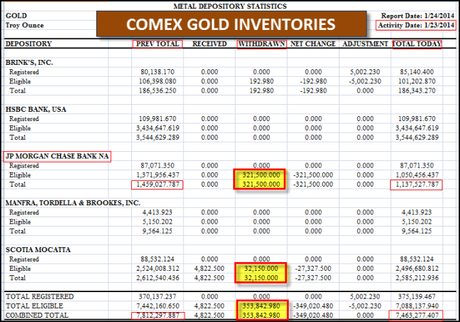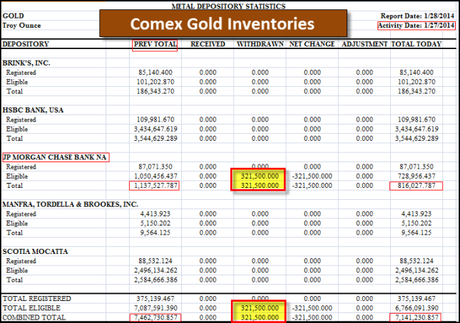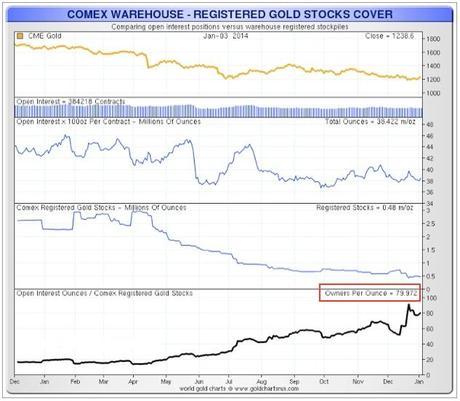A couple of charts from Comex suggest that a “bank run” against JPMorgan’s gold inventory might be in progress.
• The first chart reflects gold bullion inventories at Comex for Thursday, January 23rd, A.D. 2014:

Comex Gold Inventories
January 23rd, A.D. 2014
At the start of business (Thursday, Jan. 23rd) JPM had 1,459,028 ounces of gold. During the day, JPM’s inventory declined by 321,500 ounces leaving an end-day balance of 1,137,528.
That’s a one-day loss of 22% of JPM’s gold bullion inventory. A 22% loss of inventory in one day should be cause for alarm since four more similar losses might exhaust JPM’s entire gold inventory.
On the same day, Comex started with 7,812,298 total ounces (including JPMs) and finished with 7,463,277 = 349,021 ounce loss for the day = 4.5% loss of initial inventory. Virtually all of that loss was caused by withdrawals from the JPM inventory. A 4.5% daily loss should not be cause for panic, but if that rate of decline continued, Comex could be out of gold in about one month.
• The next chart reflects Comex gold bullion inventory activity, three working days later, on Monday, January 27th:

Comex Gold Inventories
January 27th, A.D. 2014
• According to the second chart (supra), on Monday, January 27th, JP Morgan lost another 321,500 ounces—a loss of 28% of the gold bullion it held at the beginning of the day.
Including the 321,500 ounces that were “withdrawn” on the previous Thursday, JPM lost forty four percent (44%) of all the physical gold it held in the Comex vaults at the beginning of business on Thursday, January 23rd. Thus, in three business days, 44% of JPM’s gold inventory was “withdrawn”.
After these two, 321,500 ounce “withdrawals,” JPM’s remaining balance was 816,028 ounces. Three more 321,500-ounce withdrawals would be enough to exhaust JPM’s current supply of gold bullion.
On that same day (Monday, January 27th) Comex started with 7,462,731 ounces of gold bullion, withdrew a net 321,500 ounces, and ended with 7,141,231 ounces. That’s a 4.3% loss for the day (virtually all of which was incurred by JPM).
• If the two 321,500 “withdrawals” are repeated, JPM could run out of Gold in the very near future. If the daily rate of withdrawals for Comex continued to exceed 4%, the entire Comex gold inventory could be exhausted in less than two months.
What happens then?
Hard to say, but for one thing, JPM (and perhaps Comex) will no longer be able to make good on any of their contracts to deliver gold.
Those owning a paper gold contract from JPM will lose their assets—at least until the resulting litigation is concluded in the following two to five years—and perhaps forever. All of which suggests that those who are holding paper debt instruments issued by JPM which promise to pay in gold may want to demand immediate physical delivery of “your” gold before everyone else does the same.
• The reason I mention “everyone else” who may seek to take “your” gold is that Comex publishes another graph which reports on “Owners Per Ounce”. (See the bottom of the following image.)
“Owners Per Ounce” indicates the ratio of how many speculators in the Comex gold market have a claims on gold in relation to each ounce of registered gold actually held in the Comex vaults.

Comex “Owners Per Ounce”
A year ago, the “Owners Per Ounce” was about 20.
Today, there appear to be about 80 “Owners Per Ounce”.
Thus, the Comex inventory appears sufficient to only deliver about 1/80th of the physical gold promised in current gold contracts.
Ratios of 20 to 80 between “Owners” and “Ounces” aren’t necessarily extraordinary. They’re similar to what we might expect to see in fractional reserve banking where banks are required by law to keep between 3% and 10% of total deposits in the bank in the form of cash.
For example, suppose a bank had $1 billion in deposits. Depending on the applicable national law, that bank might be required to hold between $30 and $100 million in its vaults to satisfy bank depositors who might want to withdraw their funds on any given day.
Banks know that, statistically, only a relatively small number of bank depositors will normally try to withdraw their deposits on any given day. Therefore, a bank holding $1 billion in deposits doesn’t need to keep all of those $1 billion in the vault every day 24/7. Instead, if the bank keeps, say, $100 million in the vault, that should be enough to see it through each day’s business. The other $900 million in deposits can therefore be loaned out to build homes and businesses, and provide consumer loans.
In the previous example, the ratio of the $1 billion in deposits to the $100 million actually held in daily “reserves” 10 to 1. Thus, there’d be effectively 10 bank depositors having a claim on each of the dollars held in “reserve” in the bank’s vault.
The Comex “Owners to Ounces” graph indicates that the gold bullion market also runs like a “fractional reserve” bank. A lot of money is invested/deposited into Comex, but only a relatively small quantity of physical gold is held in reserve to satisfy investor demands. There’s relatively little physical gold held in the Comex vaults because Comex knows that, historically, only a relatively few gold market investors actually take physical delivery of gold. Virtually everyone who has speculated in the gold market has preferred to take their profits in the form of checks for fiat dollars rather than physical gold.
At least, that was true up until about a year ago.
• According the “Owners Per Ounces” graph, a year ago, the ratio of “Owners” to “Ounces” in the in the gold bullion commodity market was about 20 to 1. In essence, there were 20 speculators who had claims on each ounce of gold held in the Comex vaults.
Conversely, you might say that the Comex gold’s fractional-reserve ratio was 20 to 1. That ratio compared favorably with the fractional reserve ratio of 10 to 1 in bank deposits to bank funds kept on hand and in the banks’ vault.
These “fractional reserve” ratios are reasonable because they’re based on historic norms. The banks know that only a relatively few people will withdraw their deposits on any given day. Comex likewise knows that, historically, only a relatively few gold speculator will withdraw physical gold on any given day.
But. If depositors lose confidence in their bank, the economy, or the Comex gold markets, they might all rush to the bank (or Comex) in a relatively short period of time to demand that the bank release all of their deposits (or Comex release all of its gold).
That would be a “bank run”.
Bank runs are dangerous because, if:
1) a bank has only $100 million in the vault; but,
2) depositors demand to withdraw over $100 million; and,
3) the bank can’t satisfy all of the depositors’ withdrawal demands; then
4) the bank may be declared insolvent and permanently closed or sold off to a larger bank.
In theory, we can expect a similar chain of events and a similar conclusion if a single Comex broker like JPM—or Comex, itself—was beset by an unusually large number speculators who demanded to take delivery of physical gold rather than accept paper checks.
• In the case of a bank run where there’s a 10 to 1 ratio of deposits to dollar reserves held in the bank’s vault, so long as no more than 10% of depositors (on average) withdraw their funds on any given day, the bank can remain solvent and in business.
In the case of the Comex gold market, last year there was a 20 to 1 ratio of “Owners” to “Ounces” of registered gold. At that time, Comex was a little more vulnerable to a “bank run” than a conventional bank that had a 10 to 1 reserve ratio. For banks, if over 10% of depositors (on average) withdrew their deposits on any one day, the bank could fail. For Comex, if over 5% of speculator (on average) demanded to take delivery of physical gold, the Comex market might fail.
That was last year.
Today, however, the “Owners Per Ounces” ratio is no longer 20 to 1—it’s 80 to 1. That implies that, on average, if just 1 current speculator out of 80 in the gold market demands to take physical delivery of his gold, the Comex gold market could collapse.
Unlike the hypothetical bank that might fail if over 10% of its depositor suddenly withdrew their funds, or the Comex gold market of last year that could fail if 5% of its speculators demanded to take physical delivery of gold, today’s Comex gold market inventory might be exhausted and Comex deemed insolvent if just 1.25% of its speculators demanded to take physical delivery of the gold bullion they’d “invested” in.
• This current Comex gold “Owners Per Ounces” ratio is dangerous but not necessarily fantastic. In any commodity, tens or scores of people “invest” in the pork bellies for every available pork belly. Likewise, tens or scores of people invest in Frozen Orange Juice Concentrate for every unit of frozen orange juice.
Virtually everyone who invests in pork bellies or Frozen Concentrated Orange Juice (FCOJ) has no intention of taking delivery 10,000 pork bellies or a truck load of FCOJ. They’re just speculating in order to get a check. They invest in pork bellies to acquire a check—not a pork belly. They invest in FCOJ to get a check, not a truckload of orange juice.
Likewise, historically, the vast majority of those who invested in gold as a commodity never intended to take delivery of the physical gold. They were simply “betting” that the price of gold would go up or down. If they bet correctly, they only wanted a check payable in dollars to celebrate their good fortune.
But, with the persistent rise in the price of gold (and correlative fall in the purchasing power of the fiat dollar) from A.D. 2000 through A.D. 2011, more and more people who bet in the Comex gold market began to realize that they were better off taking delivery of the physical gold than they were taking “delivery” of a paper check for fiat dollars.
Results?
- More and more people began to take delivery of physical gold.
2. The gold vaults at Comex (and perhaps the US Treasury and Federal Reserve) began to empty.
3. People in positions of power realized that if Comex, the US Treasury and the Federal Reserve continued to hemorrhage physical gold, they’d soon run out, and be recognized as unable to make good on any of their contracts to deliver physical gold.
4. At that point, the gold-price-manipulation scheme would collapse.
5. The price of gold would rise significantly and perhaps skyrocket; and,
6. The perceived value of the fiat dollar would collapse.
• Implication? It seems likely that The Powers That Be recognized that investors in the gold commodity markets were demanding delivery of physical gold because they believed the price of gold would continue rising.
If so, it seems reasonable to presume that, in order to protect the fiat dollar, the Powers That Be decided to crush the price of gold and thereby destroy the incentive to take physical delivery of gold rather than take a check for fiat dollars.
In support of this speculation, we know that:
- Comex began hemorrhaging gold in the first week of February, A.D. 2013 when it held almost 2.9 million ounces of registered gold.
- In the first week of February, A.D. 2013, the price of gold was about $1,675.
- By December of A.D. 2013, the price of gold had fallen to $1,195—a staggering loss of $480/ounce or 29% loss in just 11 months.
- During that same period (February through December A.D. 2013) the Comex vaults’ supply of registered gold fell from 2.9 million to 375,140 ounces. While gold’s price fell 29%, the Comex inventory of registered gold fell 2.86 million ounces. That’s a loss of 87% of registered gold inventory in less than 11 months That’s a slow-moving bank run on the Comex gold market. It’s not as dramatic as a one day, or one week bank run on a traditional bank, but It’s still a bank run.
- Between January 23rd and January 27th, JPM suffered a 44% loss of physical gold. Now, that’s a “bank run” in th gold market that’s almost as sudden and dramatic as the “runs” seen on conventional banks.
If it were true that the Powers That Be intentionally pushed gold’s price down by 29% in A.D. 2013 in order to stop gold commodity investors from taking physical delivery of gold from Comex vaults, their plan backfired. Because gold was as such low levels, the global demand for physical gold increased and the supply in Comex vaults fell by 87% in just 11 months.
It would be an astonishing irony if the Powers’ attempt to crush the price of gold resulted in such an enormous increase in demand for gold that the Powers themselves were forced to lose much of their gold in order to protect the fiat dollar.
But regardless of whose gold is being sold and lost, the numbers on the Comex graphs suggest that the end is near. JPM (which lost 44% of its gold inventory in less than a week) could lose the remainder in another week, and will probably lose the remainder in the next 90 days. Comex (which has lost 87% of its registered gold inventory in 11 months) might lose the remaining 13% in the next month, and will probably lose that 13% in the next 90 days.
If JPM and/or Comex exhaust their gold inventories, the gold price manipulation scheme should end and the price of gold should increase dramatically.
Insofar as the Comex gold inventory has plummeted with artificially low prices, it follows that the only way JPM and Comex may be able to avoid losing all of their gold inventory is to allow the price of gold to once again rise. Thus, if JPM and/or Comex want to preserve whatever gold they still have, they’ll have to allow the price of gold to rise.
Either way, it appears likely that the price of gold should enjoy a significant increase over the next 90 days. More, once that rise begins, it’s not likely to be stopped again by a new round of gold price manipulation.
